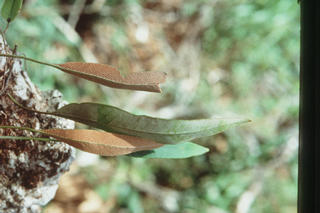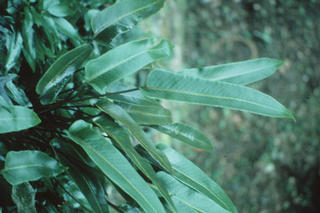Pyrrosia lingua
Contents
Nomenclature
Other Names:
Historical Use of Pyrrosia lingua
Pyrrosia lingua in Traditional Chinese Medicine
Background
Chinese Name (pinyin): Shiwei
Chinese Name :
Common Name :Pyrrosia Leaf
Specific Name : Folium pyrrosiae
Scientific Name:
Collection : The drug is collected all year round, removed from rhizome and root and dried in the sun or shade.
Description : Leaf of Pyrrosia sheareri: Fronds slightly crumpled, when whole lanceolate, 10 - 25cm long, 3 - 5cm wide, apex acuminate, base auriculate oblique, margins entire, edges usually rolled inwards, upper surface yellowish green or greyish-green, sparsely black rounded pitted, lower surface densely covered with reddish brown stelllate hairs, sometimes lateral veins completely covered with brown rounded spotted sori. Stipes with 4 ribs 10 - 20cm long, 1.5 - 3mm in diameter, slightly twisted, grooved longitudinally. Fronds leathery, odor slight, taste slightly astringent and bitter.
Identification : Powder: Stellate hairs with a 6 - 12 celled body, showing a radiate arrangement of upper and lower rows, surface sometimes smooth or with longitudinal or irregular striations and a 1 - 9 celled stalk. Spores ellipsoid in pollar view and kidney shaped in equatorial view with warty walls. Ring cells of aporrangia rectangular in surface view. Lower epidermal cells of leaf polyangular with beaded anticlinal walls and subrounded stomata. Fibres fusiform, filled with reddish brown or brown masses.
Processing : Eliminate foreign matter, wash clean, cut into section, dry in the sun and sift.
Action : To induce diuresis, relieve dysuria, remove heat and arrest bleeding.
Indication : to induce diuresis, relieve dysuria, remove heat and arrest bleeding
Precautions :
Dosage : 6 to 12 g.
Storage : Preserve in a ventilated dry place.
Synonymns for Pyrrosia lingua
Patent Medicines and Medicines with Multiple Ingredients that include Pyrrosia lingua
Pharmaceutical Information
Chemical Constituents
Evidence or the Use of Pyrrosia lingua in the Treatment of Epilepesy
Basic Science
Animal Studies
Cohort, Case-Control and Non-Randomized Trials
Randomized Controlled Trials
Meta-Analysis
1st Five Results: pubmed search
Haibo Hu, Guojing Zhao, Kun Wang, Ping Han, Haiyan Ye, Fengchan Wang, Na Liu, Peixia Zhou, Xuechao Lu, Zhaoshan Zhou, Huantian Cui
Study on the Mechanism of Qing-Fei-Shen-Shi Decoction on Asthma Based on Integrated 16S rRNA Sequencing and Untargeted Metabolomics.
Evid Based Complement Alternat Med: 2023, 2023;1456844
[PubMed:36846048]
[WorldCat.org]
[DOI]
(P e)
Xiangwei Xu, Jun Chen, Haiou Lv, Yiyuan Xi, Aiying Ying, Xiang Hu
Molecular mechanism of Pyrrosia lingua in the treatment of nephrolithiasis: Network pharmacology analysis and in vivo experimental verification.
Phytomedicine: 2022, 98;153929
[PubMed:35104754]
[WorldCat.org]
[DOI]
(I p)
Seon-A Jang, Youn-Hwan Hwang, Hyun Yang, Jin Ah Ryuk, Dong Ryun Gu, Hyunil Ha
Ethanolic extract of Pyrrosia lingua (Thunb.) Farw. ameliorates OVX-induced bone loss and RANKL-induced osteoclastogenesis.
Biomed Pharmacother: 2022, 147;112640
[PubMed:35033946]
[WorldCat.org]
[DOI]
(I p)
Ambreen Shoaib, Lubna Azmi, Ila Shukla, Saad S Alqahtani, Ibrahim A Alsarra, Faiyaz Shakeel
Properties of Ethnomedicinal Plants and Their Bioactive Compounds: Possible Use for COVID-19 Prevention and Treatment.
Curr Pharm Des: 2021, 27(13);1579-1587
[PubMed:33155905]
[WorldCat.org]
[DOI]
(I p)
Bikash Adhikari, Bishnu P Marasini, Binod Rayamajhee, Bibek Raj Bhattarai, Ganesh Lamichhane, Karan Khadayat, Achyut Adhikari, Santosh Khanal, Niranjan Parajuli
Potential roles of medicinal plants for the treatment of viral diseases focusing on COVID-19: A review.
Phytother Res: 2021, 35(3);1298-1312
[PubMed:33037698]
[WorldCat.org]
[DOI]
(I p)



